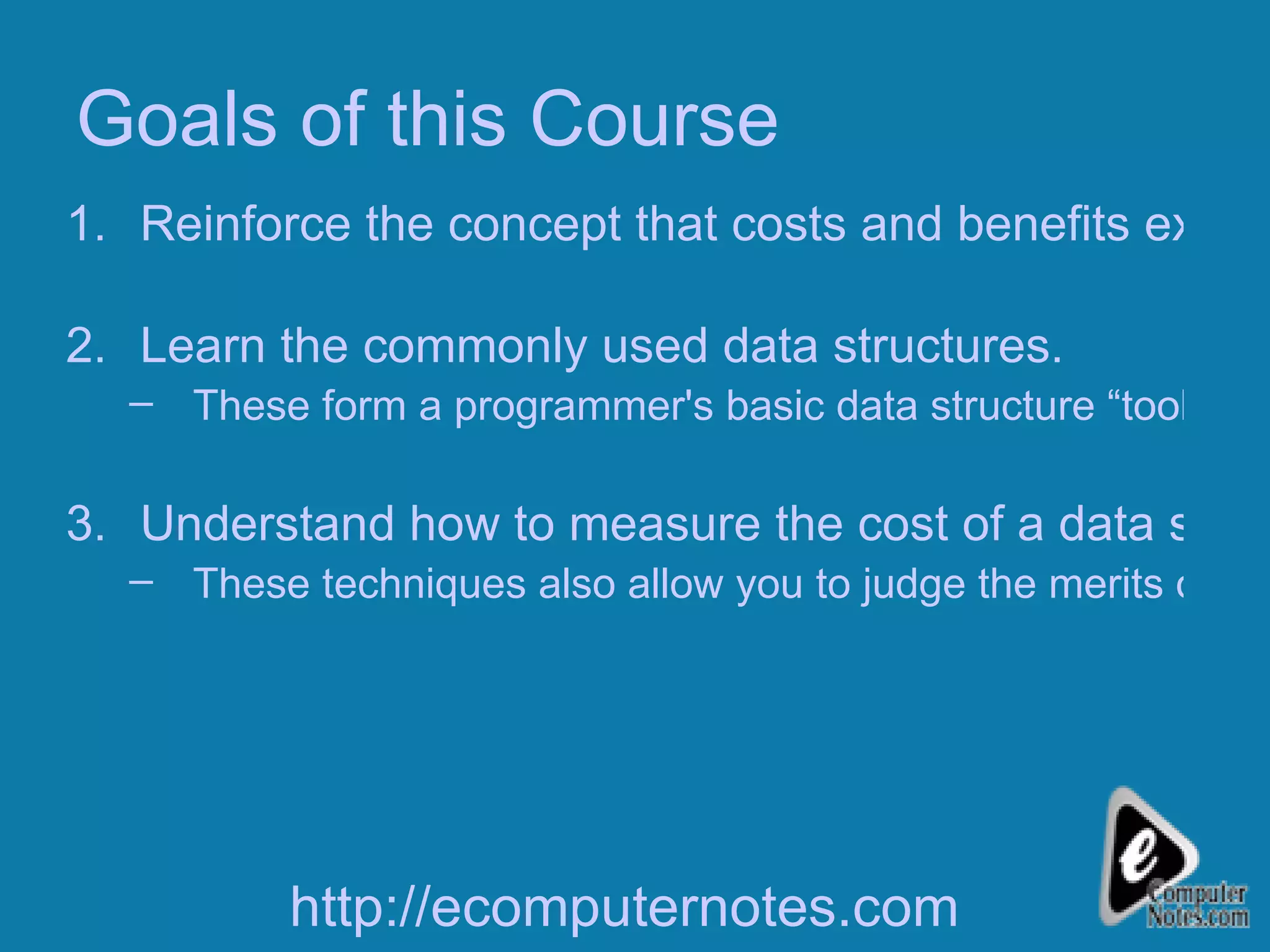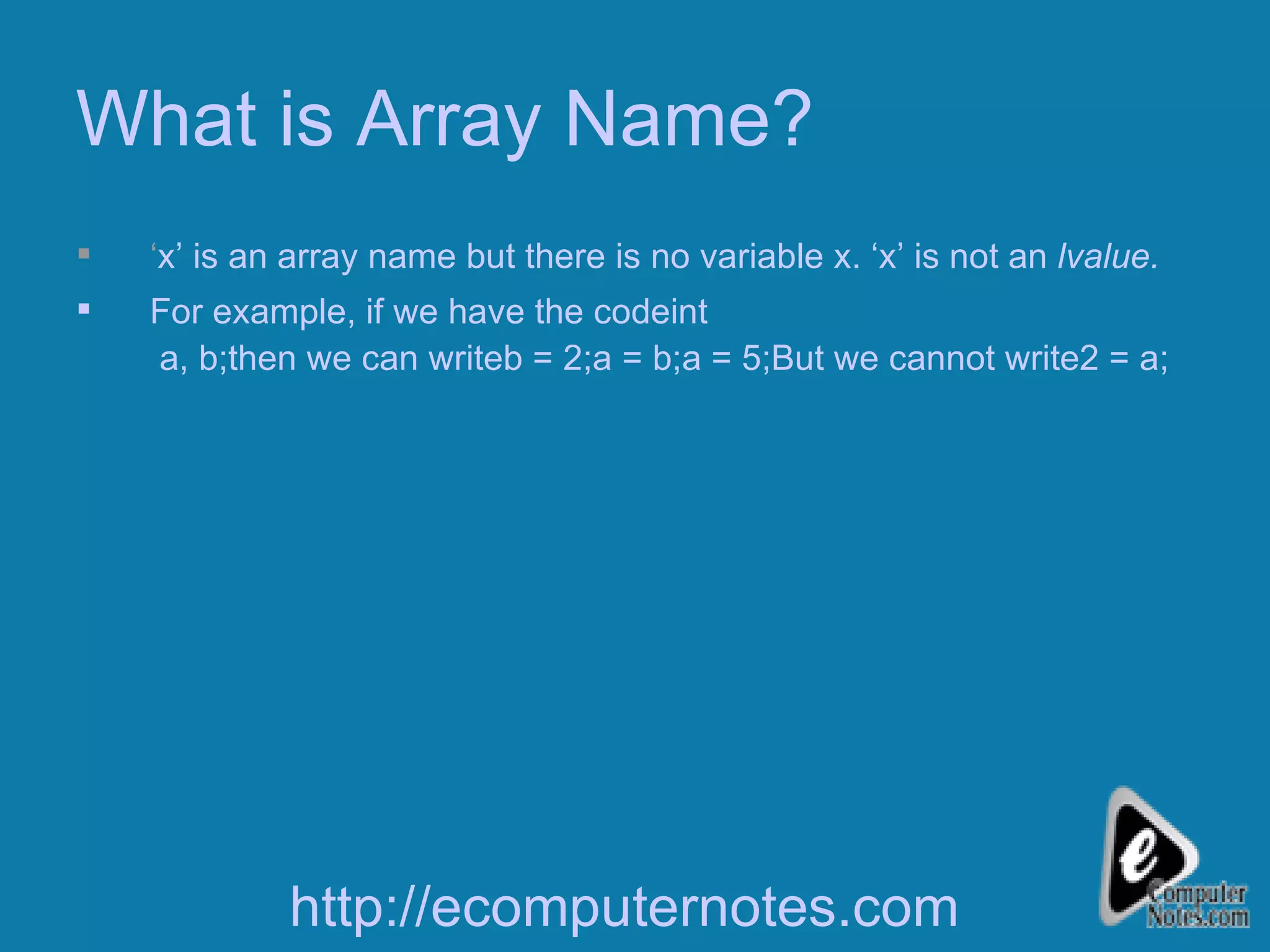The document outlines the fundamentals of data structures, detailing common types such as arrays, linked lists, stacks, queues, trees, and graphs. It emphasizes the importance of selecting appropriate data structures to optimize program efficiency based on resource constraints and basic operations. Furthermore, the course aims to equip students with a toolkit of data structures and techniques to evaluate their performance.























![Arrays Elementary data structure that exists as built-in in most programming languages. main( int argc , char** argv ) { int x[6]; int j; for(j =0; j < 6; j++) x[j ] = 2*j; } http://ecomputernotes.com](https://crownmelresort.com/image.slidesharecdn.com/computernotes-datastructures-1-111227202226-phpapp02/75/Computer-notes-data-structures-24-2048.jpg)
![Arrays Array declaration: int x[6]; An array is collection of cells of the same type. The collection has the name ‘x’. The cells are numbered with consecutive integers. To access a cell, use the array name and an index: x[0], x[1], x[2], x[3], x[4], x[5] http://ecomputernotes.com](https://crownmelresort.com/image.slidesharecdn.com/computernotes-datastructures-1-111227202226-phpapp02/75/Computer-notes-data-structures-25-2048.jpg)
![Array Layout x[1] x[2] x[3] x[4] x[5] x[0] Array cells are contiguous in computer memory The memory can be thought of as an array http://ecomputernotes.com](https://crownmelresort.com/image.slidesharecdn.com/computernotes-datastructures-1-111227202226-phpapp02/75/Computer-notes-data-structures-26-2048.jpg)



![Array Name ‘x’ is not an lvalue int x[6]; int n; x[0] = 5; x[1] = 2; x = 3; // not allowed x = a + b; // not allowed x = &n; // not allowed http://ecomputernotes.com](https://crownmelresort.com/image.slidesharecdn.com/computernotes-datastructures-1-111227202226-phpapp02/75/Computer-notes-data-structures-30-2048.jpg)
![Array Name ‘x’ is not an lvalue int x[6]; int n; x[0] = 5; x[1] = 2; x = 3; // not allowed x = a + b; // not allowed x = &n; // not allowed http://ecomputernotes.com](https://crownmelresort.com/image.slidesharecdn.com/computernotes-datastructures-1-111227202226-phpapp02/75/Computer-notes-data-structures-31-2048.jpg)
![Dynamic Arrays You would like to use an array data structure but you do not know the size of the array at compile time. You find out when the program executes that you need an integer array of size n=20. Allocate an array using the new operator: int * y = new int[20]; // or int * y = new int[n ]y[0] = 10;y[1] = 15; // use is the same http://ecomputernotes.com](https://crownmelresort.com/image.slidesharecdn.com/computernotes-datastructures-1-111227202226-phpapp02/75/Computer-notes-data-structures-32-2048.jpg)
![Dynamic Arrays You would like to use an array data structure but you do not know the size of the array at compile time. You find out when the program executes that you need an integer array of size n=20. Allocate an array using the new operator: int * y = new int[20]; // or int * y = new int[n ]y[0] = 10;y[1] = 15; // use is the same http://ecomputernotes.com](https://crownmelresort.com/image.slidesharecdn.com/computernotes-datastructures-1-111227202226-phpapp02/75/Computer-notes-data-structures-33-2048.jpg)
![Dynamic Arrays You would like to use an array data structure but you do not know the size of the array at compile time. You find out when the program executes that you need an integer array of size n=20. Allocate an array using the new operator: int* y = new int[20]; // or int* y = new int[n] y[0] = 10; y[1] = 15; // use is the same http://ecomputernotes.com](https://crownmelresort.com/image.slidesharecdn.com/computernotes-datastructures-1-111227202226-phpapp02/75/Computer-notes-data-structures-34-2048.jpg)
![Dynamic Arrays ‘ y’ is a lvalue; it is a pointer that holds the address of 20 consecutive cells in memory. It can be assigned a value. The new operator returns as address that is stored in y. We can write: y = &x[0]; y = x; // x can appear on the right // y gets the address of the // first cell of the x array http://ecomputernotes.com](https://crownmelresort.com/image.slidesharecdn.com/computernotes-datastructures-1-111227202226-phpapp02/75/Computer-notes-data-structures-35-2048.jpg)
![Dynamic Arrays ‘ y’ is a lvalue; it is a pointer that holds the address of 20 consecutive cells in memory. It can be assigned a value. The new operator returns as address that is stored in y. We can write: y = &x[0]; y = x; // x can appear on the right // y gets the address of the // first cell of the x array http://ecomputernotes.com](https://crownmelresort.com/image.slidesharecdn.com/computernotes-datastructures-1-111227202226-phpapp02/75/Computer-notes-data-structures-36-2048.jpg)
![Dynamic Arrays ‘ y’ is a lvalue; it is a pointer that holds the address of 20 consecutive cells in memory. It can be assigned a value. The new operator returns as address that is stored in y. We can write: y = &x[0]; y = x; // x can appear on the right // y gets the address of the // first cell of the x array http://ecomputernotes.com](https://crownmelresort.com/image.slidesharecdn.com/computernotes-datastructures-1-111227202226-phpapp02/75/Computer-notes-data-structures-37-2048.jpg)
![Dynamic Arrays We must free the memory we got using the new operator once we are done with the y array. delete[ ] y; We would not do this to the x array because we did not use new to create it. http://ecomputernotes.com](https://crownmelresort.com/image.slidesharecdn.com/computernotes-datastructures-1-111227202226-phpapp02/75/Computer-notes-data-structures-38-2048.jpg)









